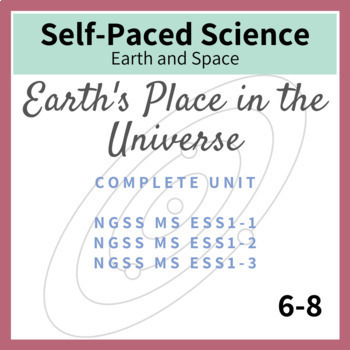Earth's Place in the Universe Middle School Astronomy Unit
- Google Drive™ folder

What educators are saying
Products in this Bundle (5)
Also included in
- This bundle includes everything you need to teach all NGSS Earth and Space Science standards in middle school for the entire year and works for both self-pacing and traditional classes! Topics covered include the water and rock cycles; weather and climate; weathering and erosion; plate tectonics, PPrice $229.00Original Price $272.81Save $43.81
Description
This complete astronomy unit has everything you need to teach NGSS MS-ESS1-1, MS-ESS1-2 and MS-ESS1-3 including editable student Slides, worksheets, hands-on investigations, final projects and extension activities. Topics covered include constellations and night sky observations; planets, asteroids and comets; scale models, gravity and motion; moon phases, eclipses, seasons and more! If you want to decrease stress for yourself and your students and help kids make personal connections to the science they are learning, try this self-paced science unit!
Combined, the five mini units will take about 10 weeks to complete.
We use scientific language in context with photographs and graphics to make our lessons accessible to readers of all levels. Students make personal connections to the science they learn and enjoy our highly engaging authentic assessments.
Our lessons are written to make self-pacing as simple as possible and also work in a traditional classroom.
The five mini units outlined below are included in this bundle:
In The Night Sky mini unit, students choose a favorite constellation, figure out how to find north and record their observations of the night sky.
In the Solar System Objects mini unit, kids learn how to navigate the immense amount of information online, create a giant Venn diagram and determine how humans could live on Mars!
In the Earth, Moon and Sun mini unit, students calculate the diameter of a basketball to determine if it would qualify for the NBA then build a scale model based on their findings!
In the Gravity and Motion in the Solar System mini unit, students play with magnets and a ball on a string, use a PhET simulation to change the force of gravity and then determine if anything in Star Wars (or their favorite space movie) is true!
Finally, in the Moon Phases, Eclipses and Seasons mini unit, students make models with flashlights, tennis balls, globes and their heads!
When you purchase this product, TpT will copy these files directly to your Drive for each mini unit:
→ Teacher outline (PDF)
→ Student slides (Google Slides)
→ Student packet (Google Docs) with answer key (PDF)
→ Summative assessment with rubric (Google Docs)
→ Extension activity slides (Google Slides)
→ Extension activity with student rubric (Google Docs)
All Google Docs and Slides are editable to better meet your specific needs.
Why would I want to self-pace my science class?
If you are tired of cramming learning into perfect 48 minute chunks or filling that extra 10 minutes of class with busy work or if your students get stressed when the bell rings as they rush to finish a lab, then self-pacing is for you!
Self-pacing creates a relaxed, stress-free learning environment for both students and teachers and supports everyone’s social and emotional needs.
Teachers trade whole class lectures for one-on-one conversations and students spend their time doing science at the pace that is right for them!
Our self-paced science lessons foster independence and higher order thinking while providing many opportunities for students to practice science and engineering skills. The three dimensions of NGSS (science and engineering practices, crosscutting concepts, disciplinary core ideas) are embedded throughout our lessons and units.
This bundle includes five mini units that work together as a complete unit of study. The standards met include NGSS MS ESS1-1, MS-ESS1-2 and MS-ESS1-3. This bundle is also a part of our Earth and Space Science NGSS Middle School Complete Curriculum.
You might also be interested in these Self-Paced Science products:
- The Geologic Time Scale Mini Unit
- Potential Energy Physical Science Mini Unit
- Multiple Intelligences Book Project - You can use this for science!
- Back to School Bundle - An Introduction to Middle School Science
Visit our Self-Paced Science store to view all of our products.
Copyright © Self-Paced Science. All rights reserved.
Permission to copy for single classroom use only.
Please purchase additional licenses if you’d like to share this product.






